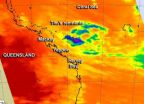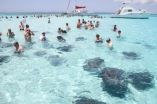(Press-News.org) 18 March 2013 – Goleta, CA., USA -- The first truly global telescope came a significant step closer to completion this month with the installation and first light on three new 1-meter telescopes at the South Africa Astronomical Observatory (SAAO) near Sutherland, South Africa. A team of five Las Cumbres engineers, technicians, and a postdoc, convened at Sutherland for three weeks during late February and early March to achieve this feat.
"The South African Astronomical Observatory is pleased to collaborate with the Las Cumbres Observatory Global Telescope project, and we are excited by the prospects for both scientific observations and public outreach activities," Ted Williams, Director of SAAO said.
Las Cumbres Observatory Global Telescope (LCOGT) has installed four other identical 1-meter telescopes to date: an operational prototype at McDonald Observatory near Fort Davis, Texas (April 2012), and a full science node of three telescopes at Cerro Tololo Inter-American Observatory (CTIO) (October 2012).
Annie Hjelstrom, the project engineer responsible for the successful installation, pointed out that, "We had a great installation team, and SAAO and SALT staff were very helpful, but this is also the culmination of eight years of design and development. Each telescope is built, configured, tested, and then dismantled at the Goleta, California headquarters before we put them back together on site."
Usually first light images are fairly dry, and several such images were taken at each of the three telescopes. But for the SAAO node, LCOGT founder and lead engineer Wayne Rosing asked former company intern and accomplished astrophotographer B. J. Fulton to acquire images from three different galaxies using the stripped-down capabilities available during the early engineering phases. Fulton, who is now an astronomy graduate student with the University of Hawaii, produced the images over the first few days of telescope operations.
Edward Gomez, Education and Outreach Director of LCOGT, wrote that Fulton "kept the integrity of a first-light image by not touching up the images in any way." The images were created using command-line tools that work directly on the raw pixel data (e.g., Python, Stiff and ImageMagick). The images do not have flat-fields, darks or biases subtracted. They each combine multiple wavelengths and colors from the use of different filters on the telescope instrument. For example, the images of M104 and M83 each required over 3 hours of exposure time distributed across two Bessel filters with additional exposures using two Sloan filters. For Trumpler 14, Fulton, took over 2 hours of images spread across three Sloan filters. He was able to conduct his observations from Hawaii, while the engineering team in Santa Barbara conducted their tests and the installation team in South Africa completed system tuning and optical collimation steps.
The installation team consisted of Hjelstrom, technicians Mark Crellin from the Birkenhead, England office, Kurt Vander Horst and David Petry from the Goleta office, and astronomy postdoctoral scholar, Abiy Tekola, based at SAAO in Capetown. The telescopes arrived on site on February 18th and were craned into the domes the next day. The telescope in Dome A was assembled with electrical, mirrors, optical tube assembly, and instrument by the end of February 20th, and the telescope went on-sky that night to begin TPOINT runs to set the telescope's polar alignment. The second and third telescopes followed over the next two days.
The trio of telescopes brings the company's total of operational 1-meter telescopes to seven. Two more are planned for mid-May at the Siding Spring Observatory to complete the southern ring, and a second telescope will be installed at McDonald Observatory at roughly year-end to create the first northern node.
A Global Telescope
LCOGT is a private, nonprofit science institute engaged in time domain astrophysics. The LCOGT Science team, led by Science Director Tim Brown, has published extensively on exoplanets, supernovae, and minor planet research, among other research areas. The organization operates the two 2-meter Faulkes Telescopes for which initial capital and operational funding was provided by The Dill Faulkes Educational Trust. LCOGT is now in the process of deploying a global network of 1-meter telescopes.
According to Brown, "The 1-meter telescope network adds a critical astronomical resource. Because the network will span both hemispheres, and because one or more LCOGT nodes will always be in the dark, astronomers can observe from anywhere on earth at nearly any time. Also, these telescopes - robotic, responsive, and numerous - will allow massive but carefully-directed observing campaigns that could never be done before."
About a third of the network science time in the southern hemisphere is dedicated to the astronomy program of the Scottish Universities Physics Alliance, of which St. Andrews University is a member. St. Andrews has worked with LCOGT over the last seven years on an exoplanet identification and characterization program using the Faulkes Telescopes and is expanding that program onto the larger LCOGT network.
LCOGT also has a science partnership with SAAO. SAAO astronomers will be using the telescopes for their science programs within the next couple of months. Tekola points out that SAAO also plans to use part of their share of network time for education and outreach in South Africa and other African countries.
As the LCOGT network expands the organization will make significant amounts of observing time available for educational projects, in addition to the substantial amount of time which will be available for professional scientists. LCOGT works with groups of education and scientific professionals to develop wide reaching partnerships for scientific research, public engagement and citizen science. Successful LCOGT education programs exist in the United States, the United Kingdom, and Australia.
Additional science and education partnerships are available.
"We're very much looking forward to getting the 1-meter network commissioned for science," LCOGT staff astronomer Rachel Street said. "These telescopes are ideal for the exoplanet characterization, supernovae follow-up and solar system studies our teams specialize in."
LCOGT uses ANSYS software.
INFORMATION:
Science contact:
Tim Brown, Science Director
805-880-1600
tbrown@lcogt.net
Engineering contact:
Annie Hjelstrom, Project Engineer
805-880-1628
ahjelstrom@lcogt.net
END
Some diseases are caused by single gene mutations. Current techniques for identifying the disease-causing gene in a patient produce hundreds of potential gene candidates, making it difficult for scientists to pinpoint the single causative gene. Now, a team of researchers led by Rockefeller University scientists have created a map of gene "shortcuts" to simplify the hunt for disease-causing genes.
The investigation, spearheaded by Yuval Itan, a postdoctoral fellow in the St. Giles Laboratory of Human Genetics of Infectious Diseases, has led to the creation of what he calls ...
Microbes from the human mouth are telling Oak Ridge National Laboratory scientists something about periodontitis and more after they cracked the genetic code of bacteria linked to the condition.
The finding, published in Proceedings of the National Academy of Sciences, profiles the SR1 bacteria, a group of microbes present in many environments, ranging from the mouth to deep within the Earth, that have never been cultivated in the laboratory. Human oral SR1 bacteria are elevated in periodontitis, a disease marked by inflammation and infection of the ligaments and bones ...
PROVIDENCE, R.I. [Brown University] — Large chunks of an ancient tectonic plate that slid under North America millions of years ago are still present under parts of central California and Mexico, according to new research led by Brown University geophysicists.
Around 100 million years ago, the Farallon oceanic plate lay between the converging Pacific and North American plates, which eventually came together to form the San Andreas fault. As those plates converged, much of the Farallon was subducted underneath North America and eventually sank deep into the mantle. Off ...
Infrared satellite imagery tells the temperature of the cloud tops within a tropical cyclone as well as the sea surface temperatures around the storms. A recent infrared image from NASA's Aqua satellite showed very little strength in the remnants of ex-cyclone Tim offshore from southeastern Queensland.
The Atmospheric Infrared Sounder (AIRS) instrument aboard NASA's Aqua satellite captured an infrared image of Cyclone Tim on March 18 at 0355 UTC (March 17 at 11:55 p.m. EDT). The AIRS image showed that cloud top temperatures had warmed significantly since the previous ...
A study in the JAMA Neurology (formerly the Archives of Neurology) suggests that controlling or preventing risk factors such as hypertension earlier in life may limit or delay the brain changes associated with Alzheimer's disease and other age-related neurological deterioration.
Dr. Karen Rodrigue, assistant professor in the UT Dallas Center for Vital Longevity (CVL), was lead author on a study that looked at whether people with both hypertension and a common gene associated with risk of Alzheimer's disease (the APOE-4 gene carried by about 20 percent of the population) ...
Stingrays living in one of the world's most famous and heavily visited ecotourism sites — Stingray City/Sandbar in the Cayman Islands — have profoundly changed their ways, raising questions about the impact of so-called "interactive ecotourism" on marine wildlife, reports a new study published March 18 in the journal PLOS ONE.
Researchers from Nova Southeastern University's Guy Harvey Research Institute in Hollywood, Fla., and the University of Rhode Island studied the southern stingray population of Stingray City — a sandbar in the Cayman Islands that draws nearly a ...
Lowering the costs of healthy foods in supermarkets increases the amount of fruits, vegetables and whole grain foods that people eat, while also appearing to reduce consumption of nutritionally less-desirable foods, according to research from the RAND Corporation.
Researchers examined a program available to members of South Africa's largest private health insurance company that provides a rebate of 10 percent or 25 percent on purchases of healthy foods. The program, started in 2009, now has about 800 participating supermarkets and enrolls more than 260,000 households. ...
CHICAGO — Many of today's running shoes feature a heavy cushioned heel. New research presented today at the 2013 Annual Meeting of the American Academy of Orthopaedic Surgeons (AAOS) found that these shoes may alter an adolescent runner's biomechanics (the forces exerted by muscles and gravity on the skeletal structure) and diminish performance.
Researchers recruited 12 adolescent competitive athletes from local track teams, and asked them to run on a treadmill in large heel trainers, track flats and without any shoes (barefoot) at four different speeds. Biomechanics ...
CHICAGO — Osteoarthritis of the hip or knee, affecting millions of Americans each year, is known to limit sexual activity. New research presented today at the 2013 Annual Meeting of the American Academy of Orthopaedic Surgeons (AAOS) found that total hip (THR) or total knee replacement (TKR) surgery improves sexual function in 90 percent of patients.
In the study, 147 patients under age 70, scheduled for primary THR or TKR, agreed to participate in a study requiring the completion of questionnaires prior to surgery, at six months post surgery, and at one year post surgery. ...
CHICAGO — New research presented today at the at the 2013 Annual Meeting of the American Academy of Orthopaedic Surgeons (AAOS) found that overall, sports and recreation musculoskeletal injuries have declined 12.4 percent in the U.S. over the past 10 years for children ages 5 to 14 years. However, injuries sustained during football and soccer continues to rise.
In 2000, the U.S. Centers for Disease Control (CDC) reported the top eight sports and recreational activities responsible for injuries in children ages 5 to 14, and estimated their annual cost at more than $33 ...


